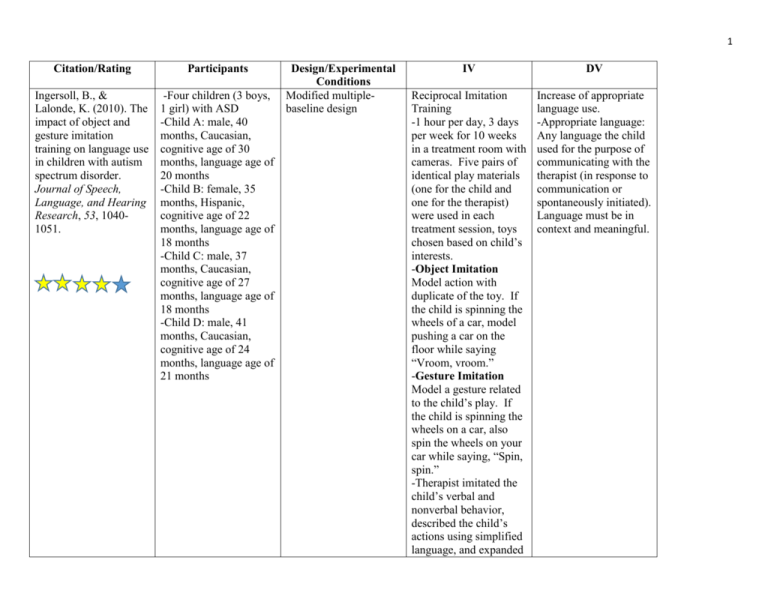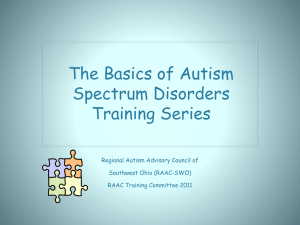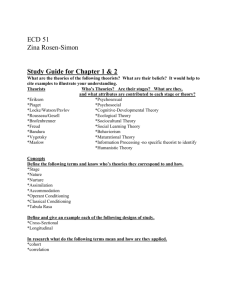Synthesis of Research on Imitation and Modeling
advertisement

1 Citation/Rating Participants Ingersoll, B., & Lalonde, K. (2010). The impact of object and gesture imitation training on language use in children with autism spectrum disorder. Journal of Speech, Language, and Hearing Research, 53, 10401051. -Four children (3 boys, 1 girl) with ASD -Child A: male, 40 months, Caucasian, cognitive age of 30 months, language age of 20 months -Child B: female, 35 months, Hispanic, cognitive age of 22 months, language age of 18 months -Child C: male, 37 months, Caucasian, cognitive age of 27 months, language age of 18 months -Child D: male, 41 months, Caucasian, cognitive age of 24 months, language age of 21 months Design/Experimental Conditions Modified multiplebaseline design IV DV Reciprocal Imitation Training -1 hour per day, 3 days per week for 10 weeks in a treatment room with cameras. Five pairs of identical play materials (one for the child and one for the therapist) were used in each treatment session, toys chosen based on child’s interests. -Object Imitation Model action with duplicate of the toy. If the child is spinning the wheels of a car, model pushing a car on the floor while saying “Vroom, vroom.” -Gesture Imitation Model a gesture related to the child’s play. If the child is spinning the wheels on a car, also spin the wheels on your car while saying, “Spin, spin.” -Therapist imitated the child’s verbal and nonverbal behavior, described the child’s actions using simplified language, and expanded Increase of appropriate language use. -Appropriate language: Any language the child used for the purpose of communicating with the therapist (in response to communication or spontaneously initiated). Language must be in context and meaningful. 2 Citation/Rating Participants Design/Experimental Conditions IV DV the child’s utterances. Ex. If the child was rolling a car on the ground, roll a car on the ground also and say, “Roll car. Car is rolling.” If the child says, “Roll car,” respond with “Roll the car” or “Roll car fast.” *If the child does not imitate after 3 times, prompt the child, say “Say roll car.” If the child does imitate, praise them. Ingersoll, B., & Schreibman, L. (2006). Teaching reciprocal imitation skills to young children with autism using a naturalistic behavioral approach: Effects on language, pretend play, and joint attention. Journal of Autism and Developmental Disorders, 36(4), 487505. Five children with Autism -Child A: male, 41 months, mental age of 29 months, language age of 25 months -Child B: female, 45 months, mental age of 23 months, language age of 22 months -Child C: female, 29 months, mental age of 15 months, language age of less than 8 months -Child D: male, 34 months, mental age of Single- subject, multiple-baseline design Naturalistic Techniques to encourage Object Imitation -3 days a week, 8 20minute sessions per week, for 10 weeks Phase I -no actions modeled Phase II -only familiar actions were modeled with the same toy Phase III -familiar and novel actions were modeled with the same toy Phase IV Increase in object imitation, combined imitation, imitative language, spontaneous language, total language, pretend play, spontaneous pretend play, appropriate play, and coordinated joint attention. Object imitation: Child imitates an action with an object within 10 seconds of the model. Imitation must not be exact, but should look 3 Citation/Rating Participants 16 months, language age of less than 8 months -Child E: male, 34 months, mental age of 16 months, language age of 17 months Design/Experimental Conditions IV DV -familiar and novel actions were modeled with a different toy Phase V -familiar and novel actions were modeled with the same and different toys Naturalistic Techniques: -contingent imitation: imitating all of the child’s actions with toys, gestures, and vocalizations, used to gain child’s attention -linguistic mapping: provide a running commentary of the actions you and the child are simultaneously performing, used to provide appropriate language models -modeling: model an action and corresponding verbal marker with the duplicate of the toy the child is manipulating, as time progresses, model with toys the child is not engaged in to encourage more flexible responding -Pivotal Response distinctly like the model. Child can use a different, but similar object. This must happen before adult models another action. Combined imitation: Child combines object imitation with verbal imitation of all or part of adult’s verbal marker Imitative language: Child imitates all or part of adult’s speech within 10 seconds of the adult’s model. Includes imitation of verbal markers and linguistic mapping. Spontaneous language: Child uses speech that was not preceded by a verbal model, question, or gestural prompt. Must be in context and meaningful. Total language: Child uses speech that was spontaneous or preceded by a verbal model, question, and gestural 4 Citation/Rating Participants Design/Experimental Conditions IV DV Training (PRT): enhances motivation by using natural reinforcement, child choice of tasks, turntaking, reinforcement of attempter responses, and maintenance tasks *Praise and reinforcement is used when the child imitates actions or vocalizations (praise verbally and allow continuous access to the toy of interest) If the child does not imitate after the third time, physically prompt the child to complete the action (hand over hand) and then provide praise prompt. Must be in context and meaningful. Total pretend play: Child performs a distinct action with miniature objects, directs a pretend action towards self, adult or inanimate object, uses object as if it were another object, attributes properties to an object which it does not have or refers to an absent object as if it were present. Spontaneous pretend play: Child performs a pretend play scheme that is not imitative (occurring within 30 seconds of a model). An imitated pretend scheme that continues more than 30 seconds after model or occurs later in the sessions is spontaneous. Appropriate Play: Child engages in paly that is appropriate to toys and context of 5 Citation/Rating Participants Design/Experimental Conditions IV DV interaction. Includes functional and pretend play Coordinated joint attention: Child spontaneously coordinates gaze between an object and adult for the purpose of sharing. Child must make eye contact with adult Rogers, S. J., Hayden, D., Hepburn, S., Charlifue-Smith, R., Hall, T., & Hayes, A. (2006). Teaching young nonverbal children with autism useful speech: A pilot study of the denver model and prompt interventions. Journal of Autism and Developmental Disorders, 36, 10071024. Ten children with Autism, nonverbal Denver Model -Child A: male, 29 months, mental age of 18 months -Child B: male, 38 months, mental age of 13 months -Child C: male, 57 months, mental age of 29 months -Child D: male, 39 months, mental age of 18 months -Child E: male, 40 months, mental age of 19 months PROMPT Model -Child F: male, 24 months, mental age of Single-subject design (A-B-A) -12, 1 hour weekly sessions of therapy and daily 1 hour home intervention delivered by parents Denver Model (merges behavioral, developmental, and relationship-oriented intervention) -Parent present and active in each session -Communication curriculum -Use social games to encourage interaction -Teach imitation of objects, actions, facial expressions, gestures, and speech sounds -Use repetitive language Functional Speech The study was looking for an increase in spontaneous word usage by the participants. 6 Citation/Rating Participants 23 months -Child G: male, 28 months, mental age of 13 months -Child H: male, 20 months, mental age of 13 months -Child I: male, 65 months, mental age of 27 months -Child J: male, 44 months, mental age of 17 months Design/Experimental Conditions IV to name -Teach object association by repetitively naming objects -Use modeling and shaping to increase verbal approximations of target words during play PROMPT-Prompts for Restructuring Oral Muscular Phonetic Targets (neurodevelopmental approach for speech production disorders) -Parents observed treatment sessions via video -Child attends to toybased activity and produces an intentional sound to request -Support child’s utterance through integrated auditory and tactile cues -Vocal modeling and actual manual manipulation of the child’s jaw, lips, and other speech mechanisms -Physical cues are DV 7 Citation/Rating Schertz, H. H., & Odom, S. L. (2007). Promoting joint attention in toddlers with autism: A parentmediated developmental model. Journal of Autism and Developmental Disorders, 37, 15621575. Participants Design/Experimental Conditions Three children with Single-subject, multiple Autism and their parents baseline design -Child A: male, 24 months, mother age 27 -Child B: male, 33 months, mother age 32 -Child C: male, 22 months, mother age 23 IV gradually faded into visual cues -Chosen activities should be motivating, within child’s mental age, and support functional interaction and independent speech across settings. Joint Attention Intervention Model -conducted in families homes -parents played face-toface games using toys present in their homes -Suggested activities were provided for each family, parents were able to use own ideas Focusing on faces: -interactive face oriented vocal games with strong rhythms -pairing looks to the face with expressions of affection -imitate facial gestures Turn-Taking: -imitation of childinitiated gestures -respond to child actions as if they were intended as interactions -embed adult actions DV Focusing on faces, turntaking, responding to joint attention, and initiating joint attention. Focusing on faces: Child looks at any part of the mother’s face during an interaction. Turn-Taking: Child performs an action, adult performs an action, and child performs another action. This is one interaction. Responding to joint attention: Child responds to an adults attempt to draw his/her attention to an object by alternating looks between the adults face and the object for the purpose of sharing 8 Citation/Rating Heimann, M., Laberg, K. E., & Nordoen, B. (2006). Imitative interaction increases social interest and elicited imitation in non-verbal children with autism. Infant and Child Development, 15, 297309. Participants Twenty children with Autism Spectrum Disorder (non-verbal) -19 boys and 1 girl -Mean chronological age of 6 years and 5 months -Mean mental age of 2 years and 1 month Design/Experimental Conditions Multiple-baseline design IV into the child’s isolated repetitive play -follow child’s lead -play teasing games Responding to joint attention: -introduce a toy after establishing eye contact -hold toy close to face when offering it to the child -use excitement to encourage child to look between toy and adult’s face Initiating joint attention: -express excitement about the child’s play with a toy Adaptation of Nadel’s “still-face” paradigm -testing room with two sets of ten identical toys -four phases, each lasting 4 minutes Still-face 1: -child enters unfamiliar room alone, where an unfamiliar adult is sitting like a statue Intervention Phase: -adult imitates everything the child does (all movements DV interest. Initiating joint attention: Child alternate’s look between the adult’s face and an object for the apparent purpose of drawing the adult’s attention to the object. Change in “Social interest” (touch, look at person, request) Experimenters were looking for the frequency of touching the adult, looking at the adult, and making requests to increase, which they refer to as “social interest” 9 Citation/Rating Participants Design/Experimental Conditions IV DV and sounds) Still-face 2: -adult returns to seat and acts statue like again Free Play: -adult plays with child without using imitation as a means of contact -adult allowed to take initiative, other than imitative Break for 30-60 minutes, then the 4phase procedure is repeated Citation Ingersoll, B., & Lalonde, K. (2010). The impact of object and gesture imitation training on language use in children with autism spectrum disorder. Journal of Speech, Language, and Hearing Research, 53, 10401051. Results Three of the four children showed greater improvements in their use of appropriate language and kept this improvement at the 2 month followup. All children showed an increase in vocabulary at post-treatment and Instruments -Motor Imitation Scale (MIS) -Noldus Observer software -Pearsons productmoment correlations -Paired toys -Bayley -Preschool language scales -Unstructured Imitation Assessment (UIA) Fidelity -Inter-related reliability obtained using Pearson’s product-moment correlations -Tests performed to test differences between correlated scores-no significant difference found -Primary rater served as a therapist Strengths/Weaknesses Strengths: -Almost all children showed improvement in appropriate language, vocabulary, and imitation skills that were maintained after intervention. Weaknesses: -Study did not include a true baseline phase therefore that cannot determine the degree to which object imitation Usability Although this intervention was done in a treatment center with therapists, I think that with proper coaching parents could do this intervention in their home. From this study, the intervention seems successful in promoting 10 Citation Ingersoll, B., & Schreibman, L. (2006). Teaching reciprocal imitation skills to young children with autism using a naturalistic behavioral approach: Effects on language, pretend play, and joint attention. Journal of Autism and Developmental Disorders, 36(4), 487-505. Results follow-up. All children improved in object and gesture imitation skills. Higher rate of verbal imitations during the gesture sessions versus the objet sessions, in 3 out of 4 children. No significant difference between the two in the other child. -All participants exhibited significant increase in their rate of imitation. In posttreatment phase, 4/5 children maintained increase of imitation and were able to generalize it. -4/5 children increased in combined imitations and 3 maintained that. -All children showed increase in imitative language, 4/5 maintained it -2/5 children Instruments -MacArthur-Bates Communication Development Inventory (MCDI) Fidelity -Motor Imitation Scale -Joint Attention Assessment -Structure Laboratory Observation (SLO) -Two groups of 32 college students in psychology were used to score videos. They were blind to the study and only answered specific questions about the children’s behaviors in the videos -video analysis -resampling procedure used to verify observed differences in treatment phases Strengths/Weaknesses Usability alone improved language. language skills. -All children in study were verbal -Primary coder provided some of the intervention -Small number of participants Strengths: -Many positive results -usability Weaknesses: -variability in response of treatment -cannot be sure about what exactly caused the changes in the children -many interventions used, hard to pinpoint what had an effect on what Although there were so many interventions used and it is hard to be sure which ones worked, I think they all have a valid place in EI. I also think they are strategies that can be used by parents and professionals. 11 Citation Rogers, S. J., Hayden, D., Hepburn, S., Charlifue-Smith, R., Hall, T., & Hayes, A. (2006). Teaching young nonverbal children with autism useful speech: A pilot study of the denver model and prompt interventions. Journal of Autism and Developmental Disorders, 36, Results increased in use of spontaneous language, and both maintained it -4/5 children increased in pretend play and 3 of them maintained it -2/5 children showed increase in spontaneous pretend play and both children maintained it -All children showed increase in their coordinated joint attention and 3 children maintained it -8/10 children demonstrated functional, spontaneous use of five or more novel words -9/10 were reported using more words -2 children did not develop functional speech -2 children had a large increase in spontaneous word use (over 50 different words) Instruments -ADOS -The Social Communicative Questionnaire (SCQ) -Mullen Scales of Early Learning -Vineland Adaptive Behavior Scales -MacArthur Communicative Development Inventory Fidelity -fidelity rating system used -fidelity of each therapist was 85% or higher for three consecutive pilot sessions Strengths/Weaknesses Usability Strengths: -positive outcomes -fidelity -success in coaching Weaknesses: -Small study with a short time span -children were generally homogeneous -long training period -parent implementation monitored only by parent report Although these interventions produced some positive results, from reading this article alone I could not reproduce either intervention. The steps for the intervention were not clearly laid out, making it difficult for anyone to be able to use either of them. Further research would be 12 Citation 1007-1024. Results Instruments Fidelity Strengths/Weaknesses Schertz, H. H., & Odom, S. L. (2007). Promoting joint attention in toddlers with autism: A parent-mediated developmental model. Journal of Autism and Developmental Disorders, 37, 1562-1575. All children improved performance -2 children showed repeated engagement in joint attention -generalization occurred in all children -The Joint Attention Mediated Learning Manual (JAML) -QSR NVivo software -inter-observer agreement -triangulation of data -daily parent notes reviewed to establish parentchild mediation fidelity Strengths: -Parent satisfaction -Positive results Weaknesses: -findings limited because of small number of participants Heimann, M., Laberg, K. E., & Nordoen, B. (2006). Imitative interaction increases social interest and elicited imitation in nonverbal children with autism. Infant and Child Development, 15, 297-309. -Significant increase in social interest (touching, looking at person and requesting) -Generalization took place with half of the children -Psycho-Educative Profile-Revised (PEP-R) -Used Observer software to analyze video -Observations coded by two observers -Reliability in all three categories Strengths: -Positive Results -supported evidence -easy to follow Weaknesses: -very short intervention -done in experimental room/setting Usability needed to know how to implement each intervention. This intervention is very usable for families, considering it was used by parents, with success, in the study. However, the study itself does not go into a ton of detail about the process of the actual intervention. Although this study yielded positive results and was easy to follow, it is not a naturalistic or family-centered intervention. It is conducted in a strange room, with a stranger. It may be able to be altered to use with parents and families however.







